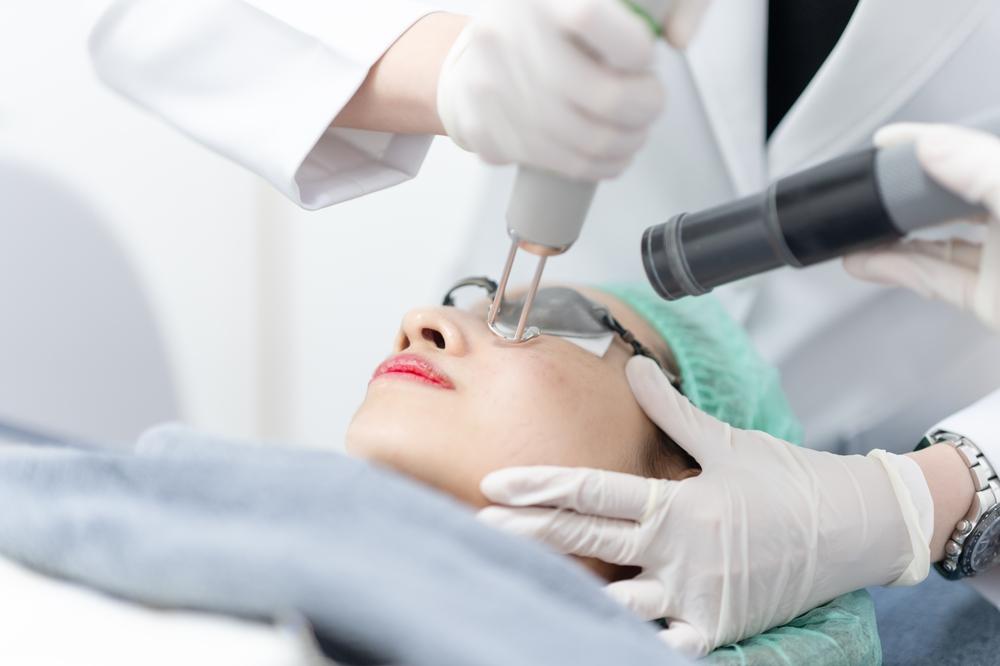Melasma is a common skin condition that affects many people, triggered by factors such as blue light emitted from everyday devices like computers and smartphones. On the “Health 1+1” program, Yen-Da Chen, director of the Sincere Dermatology Clinic in Taiwan, shared valuable insights into the various causes of melasma and highlighted safe, effective treatment options.
Causes of Melasma
Melasma, also known as chloasma, present in various forms depending on its severity. Mild cases typically manifest as gray-brown pigmentation on both cheekbones with indistinct edges, Chen said. As additional triggering factors accumulate, more severe melasma may gradually develop, with pigmentation extending upward to the eye area and forehead, downward to the cheeks, and even around the nose and lips. This extensive discoloration can significantly impact one’s appearance.
According to Chen, potential causes of melasma include the following:
- Genetic Predisposition: Melasma and other pigmentation disorders are particularly common among people of Asian descent.
- Gender: Women are more susceptible to melasma than men. Research has shown that female hormones are a significant risk factor, especially during periods of hormonal fluctuations such as pregnancy and menopause.
- UV Exposure: Ultraviolet rays are a major contributor to various types of pigmentation. Prolonged exposure to sunlight increases pigment production.
- Prolonged Blue Light Exposure: Blue light, which is part of the visible light spectrum and closely related to ultraviolet rays, has been found to stimulate melanogenesis (melanin production). Extended use of electronic devices like computers and smartphones exposes the skin to blue light, increasing melanin production and darkening the skin.
- Skin Aging: As the skin ages, melanocytes (pigment-producing cells) become less stable, making the skin more prone to melanin accumulation. This is why dark spots are more common in older adults.
- Stress and Hormonal Changes: Stress hormones can influence pigment production, making dark spots more noticeable. Maintaining a balanced diet, getting enough sleep, and managing stress effectively can help reduce pigmentation over time.
- Skin Inflammation: Using inappropriate skin care products can cause skin inflammation, which may lead to pigmentation and trigger melasma. For example, products containing alcohol, fragrances, or essential oils that can irritate sensitive skin; skincare or makeup products containing ingredients that clog pores, such as heavy oils (e.g., coconut oil, cocoa butter), which may cause inflammation. Conditions like rosacea, which causes redness and visible blood vessels on the face, can also exacerbate skin inflammation, contributing to melasma if left unaddressed.
Safe Treatments for Melasma
Melasma is particularly difficult to manage due to its diverse and hard-to-control triggers, Chen said. Its pigmentation tends to fluctuate in response to these triggers, making it a recurrent and unpredictable condition. Regular treatment is essential to maintain healthy skin and keep its symptoms under control.
While complete cures for melasma are elusive, effective management is possible through targeted supportive measures. Chen recommends a three-pronged approach:
Inhibiting Melanin Production
The enzyme tyrosinase plays a crucial role in melanin synthesis. Active ingredients such as azelaic acid, tranexamic acid, and
kojic acid can effectively inhibit tyrosinase activity in melanocytes, thereby reducing melanin production.
Additionally, antioxidants like vitamin C and glutathione help neutralize oxidative free radicals in the skin, which reduces the stimulation of melanocytes and further suppresses melanin production.
Accelerating Melanin Metabolism
Melanin is distributed at varying depths within the skin, with some concentrated in the surface layers and others deeper within. For deeper melanin deposits, aesthetic treatments such as Q-switched lasers, picosecond lasers, and intense pulsed light (IPL) can break down larger pigment particles into smaller ones. This allows the skin’s macrophages (a type of immune cells) to break down and clear these particles more effectively, gradually fading dark spots.
Chen emphasized the importance of consulting a qualified physician for a comprehensive assessment and personalized treatment plan before undergoing any laser procedures.
For surface-level melanin, whitening products containing acids can accelerate skin cell turnover, helping to metabolize accumulated melanin in the epidermis more quickly. However, this method is recommended only for people with stable skin conditions.
Enhancing Skin Health
Improving the overall condition of the skin helps stabilize melanocytes and prevents overproduction of melanin.
Radiofrequency microneedling, which involves pricking the skin with tiny sterilized needles, is a cosmetic treatment available on the market for addressing melasma, Chen said. This therapy combines microneedling with radiofrequency energy to stimulate the production of new collagen, which repairs and enhances skin health. As a result, melanocytes become more stable, leading to the gradual fading of melasma.
Potential Risks of Whitening Creams
Some people use a triple-combination whitening cream to treat melasma, which typically contains a mix of tretinoin, hydroquinone, and a mild corticosteroid.
Although once popular for its efficacy, Chen notes a decline in its use due to significant concerns:
- High Recurrence Rate: Discontinuing use without addressing underlying triggers often leads to rapid recurrence of melasma.
- Strong Irritation: Hydroquinone and tretinoin are highly irritating, and prolonged use can cause
inflammation, itching, stinging, redness.
- Corticosteroid Side Effects: Even mild corticosteroids, when used long-term, can lead to skin thinning, redness, the appearance of broken capillaries, and a weakened skin barrier. This compromised skin barrier may encourage the overgrowth of bacteria or Demodex mites (face mites), potentially triggering rosacea symptoms.
- Hydroquinone Side Effects: Prolonged use of hydroquinone can result in exogenous ochronosis, a condition characterized by dark pigmentation that is deeper and more difficult to remove than melasma itself.

Photos of exogenous ochronosis. (The Epoch Times)
Hydroquinone and topical tretinoin are classified as prescription medications and cannot legally be included in over-the-counter skin care products. However, some whitening products may contain these ingredients unlawfully, potentially causing inflammation and pigmentation issues after use, Chen warned. To avoid unnecessary skin damage, it is crucial to carefully select products and verify their safety.
Skin Care Tips
People with melasma should first identify if they have sensitive skin before selecting skincare products, Chen said. In his clinical practice, he said he had observed that many melasma patients have skin that appears both darkened and flushed. For those experiencing sensitivity and redness, consulting a dermatologist for diagnosis and treatment is essential to stabilize the skin before starting pigmentation-reducing therapies.
Chen recommends two key strategies for choosing whitening and pigmentation-reducing products:
- Opt for Gentle Formulas: Skin care products for the face should be mild and non-irritating, causing no discomfort or adverse reactions.
- Conduct a Patch Test: Before applying a new product to the entire face, test it on a small area in front of the ears and monitor for a week. If no issues arise, you can proceed with full-face application.
Selecting the right cleanser is particularly important for melasma patients with sensitive skin, Chen said. They should opt for gentle, moisturizing cleansers that leave the skin feeling soft and hydrated rather than dry and tight. He recommends using amino acid-based cleansers or products specifically formulated for sensitive skin or rosacea.
Chen also warns against using soap for facial cleansing, as it can leave the skin feeling dry and tight—common signs of over-cleansing. Over time, excessive cleansing can weaken the skin and increase sensitivity.
Melasma is particularly reactive to ultraviolet rays, making sun protection essential. “Patients undergoing melasma treatment should avoid going outdoors between 10 a.m. and 2 p.m., and during the summer, between 9 a.m. and 4 p.m.,” Chen advised. If outdoor activities are unavoidable, sunscreen should be reapplied every two hours.
It is important to note that most ultraviolet rays can penetrate clouds even on overcast days, causing damage to the skin. Therefore, consistent sun protection is vital, regardless of the weather.












